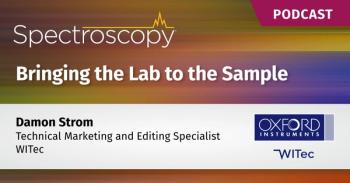Articles by Oxford Instruments WITec

Confocal Raman microscopy enables detailed and non-destructive analysis of semiconductors. In the video we present the application of confocal Raman microscopy to analyze material characteristics including doping, stress fields, crystallinity and warpage of a 150 mm (6 inch) silicon carbide (SiC) wafer. To maintain this nanoscale-precision across the macroscopically large x and y dimensions of an entire wafer, we used the WITec alpha300 Semiconductor Edition Raman microscope.

Modular Raman imaging microscopes provide a toolset
for configuring experiments that can integrate complementary methods and evolve along with individual requirements.
Following an introduction to the theoretical background, Dr. Ievgeniia Iermak will describe several of its variations
including 3D Raman imaging and optical profilometry-guided measurements. Examples will be provided to demonstrate Raman imaging’s chemical sensitivity, high resolution, ease of use, and versatility for pharmaceutical research.

In this poster presentation applications manager Ute Schmidt discusses the use of correlative Raman-SEM (RISE Microscopy) imaging for analyzing silicon-carbide (SiC) ceramics. The main focus of the work is investigating the distribution of sub-micron structured polytypes of SiC grains on and below the surface.

This study describes the generation of 3D confocal Raman images of pharmaceutical, food science, semiconductor, chemical and geoscience samples.

2D materials such as graphene and transition metal dichalcogenides are well-suited to investigation by Raman and SEM. Examples of both are presented in the following.

WITec ParticleScout uses white-light microscopy and Raman spectroscopy to find, classify and identify microparticles over large sample areas.

Correlative Raman Microscopy for 2D Materials (New text= 2D materials such as graphene and transition metal dichalcogenides are well-suited to investigation by Raman and SEM. Examples of both are presented in this application note.)

Europe’s preeminent annual conference for Raman microscopy brings the international community together and offers a stage for presenting the field’s latest discoveries.

2D materials such as graphene and transition metal dichalcogenides are well-suited to investigation by Raman and SEM. Examples of both are presented in the following.

This survey shows how Raman imaging can characterize food samples to help understand the products and production processes.

See how Raman microscopy in combination with SEM, AFM, topographic imaging and other methods can characterize chemical and structural properties of geoscience samples.

2D materials such as graphene and transition metal dichalcogenides are well-suited to investigation by Raman and SEM. Examples of both are presented in the following.

This whitepaper describes applications of cryoRaman, a cryogenic Raman microscope offering VIS to NIR excitation, high magnetic fields, and full polarization control.

In this episode, Damon Strom from WITec’s marketing department, recounts how alphaCART, their portable, research-grade Raman system, joined the alpha300 line of production instruments. Listen to the podcast for a rare glimpse into the development process at Raman microscopy’s most innovative shop.

In this episode, Damon Strom from WITec’s marketing department, recounts how alphaCART, their portable, research-grade Raman system, joined the alpha300 line of production instruments. Listen to the podcast for a rare glimpse into the development process at Raman microscopy’s most innovative shop.

This overview of advanced microparticle analysis shows how particles can be found, classified and then identified automatically using confocal Raman microscopy.

See Raman imaging investigate living cell components & plant cell walls, recognize atherosclerosis, differentiate malignant cells, monitor lipid uptake, and more.

This study describes the generation of 3D images of pharmaceutical, biological and geological samples using image stacking enabled by a highly confocal beam geometry.

See Raman imaging investigate living cell components & plant cell walls, recognize atherosclerosis, differentiate malignant cells, monitor lipid uptake, and more.

This overview of advanced microparticle analysis shows how particles can be found, classified and then identified automatically using confocal Raman microscopy.

This study shows correlative Raman imaging, atomic force microscopy and scanning near-field optical microscopy measurements that characterize polymer samples.

See how Raman microscopy in combination with SEM, AFM, and other methods can characterize chemical and structural properties of geoscience samples.

This application note shows correlative Raman-SEM-EDS imaging investigations of Li-ion batteries that reveal charge cycle-induced chemical and structural changes.

